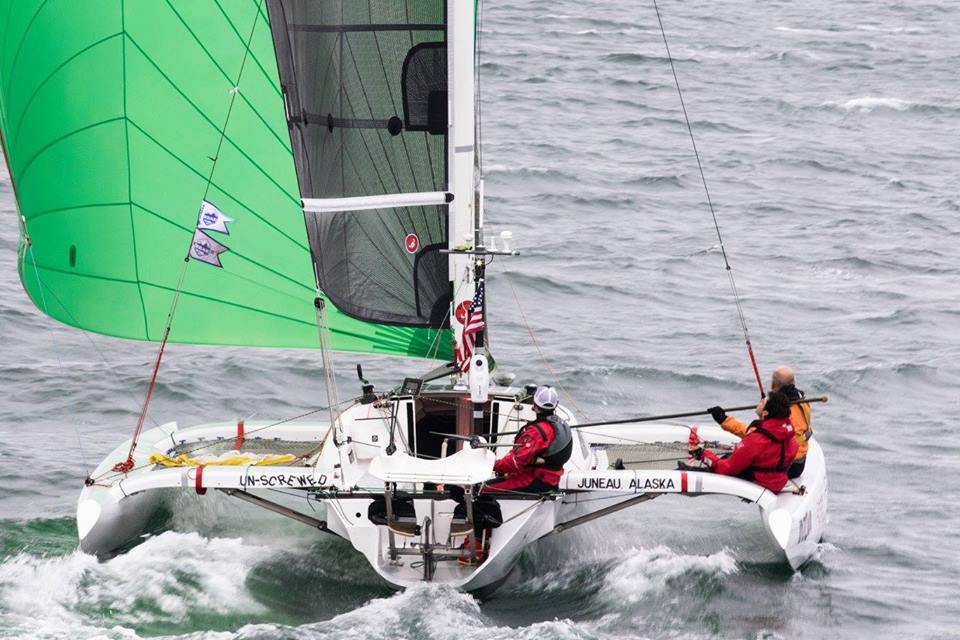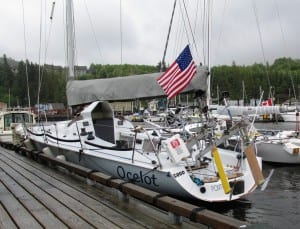
Dan Blanchard’s Team UnCruise Adventures competes in 2016’s Race to Alaska on board the 25-foot trimaran Un-Screwed. The team can’t race this year. (Photo courtesy Dan Blanchard)
No Alaskans are competing in this year’s Race to Alaska. The Washington state-to-Ketchikan competition will have close to 40 motorless watercraft. But the only team from the contest’s namesake destination has withdrawn.
Dan Blanchard is CEO of UnCruise Adventures, which sails small tour ships in Southeast Alaska, the Pacific Northwest and some other parts of the world.
He’s also captain of a three-person team that’s sailed a 25-foot trimaran sailboat during the 2015 and 2016 Race to Alaska contests.
As a part-time Juneau resident, and a major race sponsor, he was the only Alaskan entered to sail in this year’s event. But, he had to withdraw.
“Like everyone, sometimes family life and work life and race life all collide at the same time. So this year it was just a time constraint. But I certainly plan on being back,” he said.
Past races have attracted a few teams from Ketchikan and elsewhere in Alaska. But most are from Washington state or British Columbia.

Race To Alaska 2016 second-place winners Team Jungle Kitty’s boat included tandem bicycles to provide propeller power in case the wind died down. (Photo by Deb Turnbull)
Organizer Daniel Evans used to live in Alaska. While Southeast and Southcentral coasts attract sailboats, he doesn’t think they have much opportunity to prepare for a 750-mile, unsupported journey.
“By and large, the wind in Alaska is blowing too hard or it’s snowing or it’s too cold. It’s just a much, much shorter cruising window” he said.
Blanchard, of the UnCruise team, said it’s also a question of timing.
“It’s challenging for Alaskans, particularly when we are very seasonal … in our work life, to bring a boat down to Port Townsend, Washington, and the commitment of what usually ends up being well over a month, even if you have a fairly short passage like we’ve had. It’s just tough to do” he said.
His team finished in about 10 days the first year and five days the second.
While most racers sail the route, others paddle kayaks, row boats or travel by sailboard.
Evans said about half of the teams are in vessels of 20 feet or less. Fifteen will travel solo.
“I would describe the people who race as huge adventurers. (They’re) people who just decided they wanted to kind of live in their skin and experience something that they would never be ever fully prepared for” he said.
And it’s not easy. Racers face strong winds, high seas, tidal currents, cold rain and, in some places, narrow passages.
Blanchard said it’s the most painful thing he’s ever done.
“I’ve described it like living inside a clothes washer on full spin for anywhere from six to 20 days. It’s not for the meek” he said.
 The Race to Alaska is actually two contests.
The Race to Alaska is actually two contests.
The first is a 40-mile qualifying voyage from the Olympic Peninsula to Victoria, on Vancouver Island. About 60 vessels are signed up for that run.
The second is 710 miles from Victoria to Ketchikan. Thirty-seven teams plan to make that journey.
The winner gets $10,000 in cash. The runner-up gets a set of steak knives. Other finishers just get to say they made it alive.





